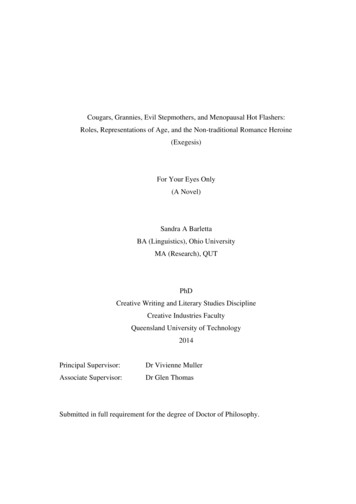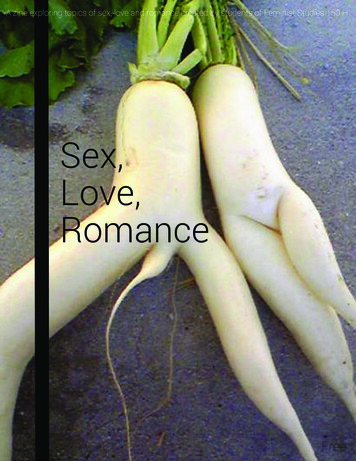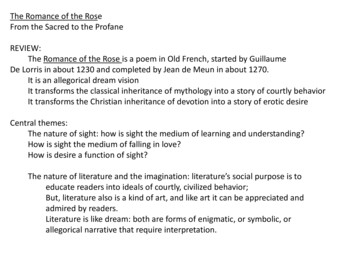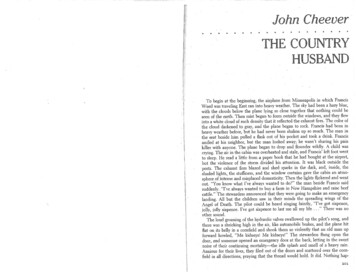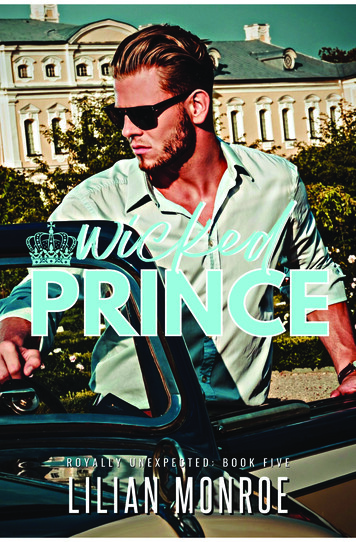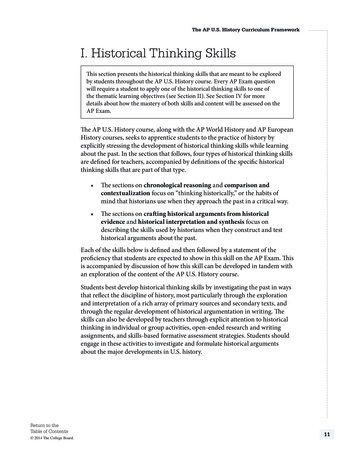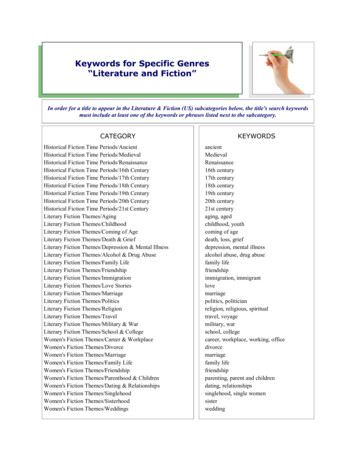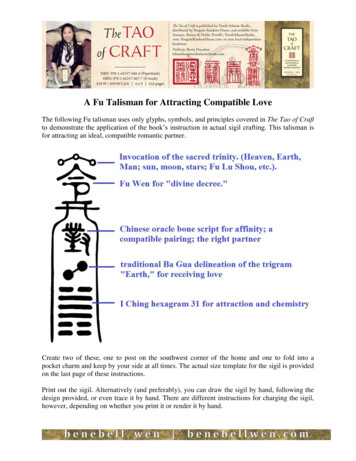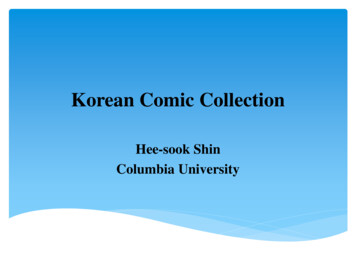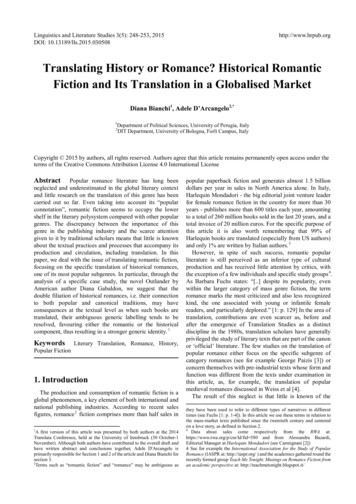
Transcription
Linguistics and Literature Studies 3(5): 248-253, 2015DOI: ating History or Romance? Historical RomanticFiction and Its Translation in a Globalised MarketDiana Bianchi1, Adele D’Arcangelo2,*1Department of Political Sciences, University of Perugia, ItalyDIT Department, University of Bologna, Forlì Campus, Italy2Copyright 2015 by authors, all rights reserved. Authors agree that this article remains permanently open access under theterms of the Creative Commons Attribution License 4.0 International LicenseAbstractPopular romance literature has long beenneglected and underestimated in the global literary contextand little research on the translation of this genre has beencarried out so far. Even taking into account its “popularconnotation”, romantic fiction seems to occupy the lowershelf in the literary polysystem compared with other populargenres. The discrepancy between the importance of thisgenre in the publishing industry and the scarce attentiongiven to it by traditional scholars means that little is knownabout the textual practices and processes that accompany itsproduction and circulation, including translation. In thispaper, we deal with the issue of translating romantic fiction,focusing on the specific translation of historical romances,one of its most popular subgenres. In particular, through theanalysis of a specific case study, the novel Outlander byAmerican author Diana Gabaldon, we suggest that thedouble filiation of historical romances, i.e. their connectionto both popular and canonical traditions, may haveconsequences at the textual level as when such books aretranslated, their ambiguous generic labelling tends to beresolved, favouring either the romantic or the historicalcomponent, thus resulting in a stronger generic identity. 1KeywordsLiterary Translation, Romance, History,Popular Fiction1. IntroductionThe production and consumption of romantic fiction is aglobal phenomenon, a key element of both international andnational publishing industries. According to recent salesfigures, romance 2 fiction comprises more than half sales in1A first version of this article was presented by both authors at the 2014Translata Conference, held at the University of Innsbruck (30 October-1November). Although both authors have contributed to the overall draft andhave written abstract and conclusions together, Adele D'Arcangelo isprimarily responsible for Section 1 and 2 of the article and Diana Bianchi forsection 3.2Terms such as “romantic fiction” and “romance” may be ambiguous aspopular paperback fiction and generates almost 1.5 billiondollars per year in sales in North America alone. In Italy,Harlequin Mondadori - the big editorial joint venture leaderfor female romance fiction in the country for more than 30years - publishes more than 600 titles each year, amountingto a total of 260 million books sold in the last 20 years, and atotal invoice of 20 million euros. For the specific purpose ofthis article it is also worth remembering that 99% ofHarlequin books are translated (especially from US authors)and only 1% are written by Italian authors. 3However, in spite of such success, romantic popularliterature is still perceived as an inferior type of culturalproduction and has received little attention by critics, withthe exception of a few individuals and specific study groups 4.As Barbara Fuchs states: “[.] despite its popularity, evenwithin the larger category of mass genre fiction, the termromance marks the most criticized and also less recognizedkind, the one associated with young or infantile femalereaders, and particularly deplored.” [1: p. 129] In the area oftranslation, contributions are even scarcer as, before andafter the emergence of Translation Studies as a distinctdiscipline in the 1980s, translation scholars have generallyprivileged the study of literary texts that are part of the canonor ‘official’ literature. The few studies on the translation ofpopular romance either focus on the specific subgenre ofcategory romances (see for example George Paizis [3]) orconcern themselves with pre-industrial texts whose form andfunction was different from the texts under examination inthis article, as, for example, the translation of popularmedieval romances discussed in Weiss et al [4].The result of this neglect is that little is known of thethey have been used to refer to different types of narratives in differenttimes (see Fuchs [1: p. 1-4]). In this article we use these terms in relation tothe mass-market texts published since the twentieth century and centeredon a love story, as defined in Section 2.3Data about sales come respectively from the RWA at:https://www.rwa.org/p/cm/ld/fid 580 and from Alessandra Bazardi,Editorial Manager at Harlequin Mondadori (see Carmignani [2])4 See for example the International Association for the Study of PopularRomance (IASPR at: http://iaspr.org/ ) and the academics gathered round therecently formed group Teach Me Tonight. Musings on Romance Fiction froman academic perspective at: http://teachmetonight.blogspot.it/
Linguistics and Literature Studies 3(5): 248-253, 2015textual practices that characterise the production of popularromantic fiction, particularly when it is translated for a newcultural context and readership.In this paper we address this issue focusing on thetranslation of historical romances, a genre that, in the lastdecades, has become particularly popular in terms of salesand international appeal. From a translational point of viewthese novels pose interesting problems as, while the romanticaspects may be seen as transnational (at least in westernculture), history is local and national and perhaps lessappealing for target readers. Since, as Shibamoto Smith [5]indicates, the audience’s expectations constitute animportant criterion when translating romantic fiction, thequestion we ask is how the different components of historicalromances are dealt with in translation, i.e. to what extent isthe historical part translated? What is adapted and/or cut out?Are any particular historical periods seen as less ‘appealing’in the target culture? Who is not translated?We will examine these issues through a specific case study,the analysis of the Italian translation of the novel Outlanderby American author Diana Gabaldon whose generic identityhas been questioned and negotiated, due to its combinationof history, fantasy and romance. Before presenting theresults of our analysis we will provide a brief overview of themain generic features of romantic fiction and, in particular,of historical romances, as the way in which these genres aredefined and understood by the operators in the field isimportant to get insights into the practices that characterizetheir consumption and circulation.2. Defining ‘Popular Romances’ and‘Historical Romances’Although definitions of “popular romances” have beenprovided within the academic environment 5 , it is ofparticular interest to see the definition given by theAssociation of the Romance Writers of America (RWA), as,for the purposes of this article, it is essential to see whichelements are to be considered fundamental in order to gainthe interest of the market, hence to generate trends not onlyin terms of sales but also in relation to the readers’ favouriteelements: in short, it is important to see what makes thesebooks popular as a market product.The RWA states that to be labelled as romance a fictionneeds to present the following aspects:A central Love Story: in a romance the main plotconcerns two people falling in love and struggling tomake the relationship work. The conflict in the bookcentres on the love story, the climax in the bookresolves the love story. A writer is welcome to as manysubplots as she 6 likes as long as the relationshipconflict is the main story5 See for example Pamela Regis [6]6 Romance novels are preeminently written by women.249An emotionally satisfying and optimistic ending:romance novels end in a way that makes the reader feelgood. Romance novels are based on the idea of aninnate emotional justice – the notion that good peoplein the world are rewarded and evil people are punished.In a romance the lovers who risk and struggle for eachother and their relationship are rewarded withemotional justice and unconditional love. [7].“Historical romance” is to be considered as a subcategoryof the romance genre, presenting all the elements listed in theabove reported definition, but within a historical context.While the historical component is clearly important, itsfunction is not easy to define. In this regard, Helen Hughesnotes howThe past setting may in such texts appear to add tothe pleasure of the book because it can be presentedas more colourful and exciting than the everyday lifeof the reader; but it may also be seen as an amnioticfluid in which the seeds of the present float [ ]romantic writers use the past as an exotic setting toadd to the escape value of their story: but it alsofunctions as a mirror for the present. [8: p. 4]In addition, it is not clear how “historical romances” differfrom another form that also presents a fictionalised historicalelement, i.e. the “historical novel”. Perhaps it would bebetter to talk of ‘historical fiction’ within which two bodiesof narratives have developed: ‘the historical romance’ and‘the historical novel’, although outlining in which way theydiffer is not easy, as Jeremy de Groot [9] has recently shownin a study discussing the features of the historical novel andits development into different subcategories. In particular, itis possible to identify a popular, uncomplicated, read-forleisure form, usually defined as ‘historical romance’, mainlyproduced and consumed by women and a ‘nobler’ form,usually seen as the offspring of a tradition dating back toWalter Scott and the development of the novel in thenineteenth century, which is usually referred to as ‘thehistorical novel’ and could be seen as being part of a7patriarchal literary canon .The genre of 'historical romance' in its contemporary form8took shape in the US in the early 1970s with writers such asKathleen Woodiwiss, whose 1972 novel The Flame and theFlower was a revolutionary book for those times, set at theturn of the nineteenth century and featuring an epic historicalromance with a strong heroine and sex scenes.Nowadays, historical romances are consumed addictivelyby millions of women, hence this is a florid economic sector7 Katherine Cooper and Emma Short also see terms as ‘historical romance’and ‘historical fiction’ as gendered labels [10]8 Although the success of Woodiwiss’s novel provided visibility to thegenre, it must not be forgotten that novels defined as “historical romances”and written by women date back to the Eighteen Century (see Cooper andShort [10]) and that, even before Kathleen Woodiwiss, other writers helpedto shape the form in the twentieth century. Kathleen Winsor pioneered thegenre in 1944 with her successful book, Forever Amber, set in theseventeenth century (the book was transposed in a film production in 1947).In UK the novels of Georgette Heyer and Barbara Cartland were alsoparticularly successful and invented the “Regency” subcategory, i.e.romantic novels set during the regency of George IV in Britain.
250Translating History or Romance? Historical Romantic Fiction and Its Translation in a Globalised Marketof the publishing market not only for the USA, but also forother countries in which translation copyrights are sold. Thereasons for this genre’s success are numerous. On the onehand, these books are perceived to have a kind ofpedagogical value: “Many readers say they not only enjoythe romance and excitement of historicals, but they feel theyare learning something about the history of a different placeand era” [11: p.113], an element also stressed by JaniceRadway’s research “readers believe it lends educationalvalue to a habit which they fear would otherwise bedismissed as escapist self-indulgence”. [12: p. 106].Other intriguing elements of the reading experience felt asessential both from source and target readers are thelocations. This is a particularly interesting issue from thepoint of view of translation problems and strategies, giventhat publishers actually decide what is worth translating alsoon the basis of its geographical setting. For example manynovels particularly successful in the US market are set in theFar West or in remote rural areas of the USA, but thesespecific themes are not considered sufficiently appealing toEuropean publishers, especially in the Italian market.Geography can become quite a problematic theme also fromthe point of view of the original writing plot, in a genredominated by US writers, for whom Europe, especiallyScotland, often seems to be regarded as a historical fantasytheme park [13: p.195].Another crucial issue in terms of writing and translatingpublishing strategies related to mass market fiction is itstendency to gloss over potentially sensitive religious matters.The genre aims at appealing to as wide a demographic profileas possible, hence some portrayals of mediaeval Catholicbeliefs and practices or religious conflicts (for instancebetween Christians and Muslims, or Catholics andProtestants) might risk alienating some readers. This is whythe so called ‘inspirational novels’ where the heroines aredeeply bound to a Protestant cultural context and backgroundare so popular in the US but are not present in theEuropean/Italian market [14].Apart from the above mentioned Harlequin Mondadori,there are several other Italian mainstream publishers workingin the sector and which have historical romance novels intheir catalogue. Among these there are two, Sonzogno andCorbaccio 9, who published the novel which is the subject ofthe present study, and whose catalogue is well known toItalian female readers for a number of successful titles withinthe field of historical romance.3. Analysis of a Case Study: the NovelOutlanderAs we have seen in the previous section, the distinction9 Sonzogno is one of the oldest Italian publisher and since the midnineteenth century, when it was founded, specialised in popular fiction,especially for women[15: p. 125]. Corbaccio is a Milan-based publishinghouse, founded in the 1920s, noted for a prestigious series of novels thatpublished, amongst others, Luis-Ferdinand Celine’s Journey to the End ofthe Night.between a ‘historical novel’ and a ‘historical romance’ is notso clear, in spite of the fact that the two labels are used todescribe books marketed in a different way and addressed todifferent segments of the reading public. The question thatwe asked is how being given a specific label affects thetranslation of books, with the aim of getting insights into thetranslation practices of popular genres and how thesepractices help to identify particular generic features.In the following case study we will examine this issue,focusing on the Italian translation of Outlander 10 [16], thefirst book in a series of novels by American writer DianaGabaldon which, since its publication in 1991, has becomean international bestseller, translated into twenty fourlanguages and the object of a number of intersemiotictranslations 11.The book tells the story of Second World War nurse ClaireRandall who, during a holiday in Scotland with her husbandin 1945, enters a circle of standing stones and finds herself ineighteenth century Scotland, just before the Jacobite Rising.Told in the first person by Claire, the book’s main focus is onthe passionate love story that develops between her andHighland warrior James Fraser, but the narrative also offersthe opportunity to describe life in the Scottish Highlands inthe eighteenth century, including references to its history. Sothe book does combine different aspects, although the lovestory between the protagonists is by far the most importantelement.The case of Outlander is particularly interesting in relationto our question because, since its initial publication, when itwas generally identified as a romance 12, the book has gonethrough a generic shift and tends now to be represented eitheras a historical novel or as a sort of “hybrid” narrativecombining the conventions of different genres, romance,history and even science fiction/fantasy as, for example, wasstated in an article published on the online magazine Salon“The smartest historical sci-fi adventure-romance story everwritten” [17]. In this process of re-interpretation DianaGabaldon herself has played an important role, using herauthority as ‘the author’ to distance the book from the ‘low’field of ‘romantic fiction’ 13 and highlighting its non-genericnature “ here we all are, still trying to figure out what theheck you call books that nobody can describe” [18].Obviously, saying that Outlander cannot be described on thebasis of the usual literary descriptors underlines its‘uniqueness’ and re-positions it within the literary hierarchy,a strategy based on the argument that genre literature can bedistinguished from ‘high literature’ thanks to the latter’s‘unique’ quality, its ‘singularity’, compared with theformulaic nature of popular genres [19:p. 40].10 In the UK the novel was published with another title, Cross Stitch, whichalso showed some differences at the textual level.11 A graphic novel with the title The Exile: An Outlander Graphic Novelwas published in 2010 by Del Rey, illustrated by Hoang Nguye, while aserialized TV version of the first book was broadcast in 2014 in the US byTV network Starz.12 In 1992 Outlander won the Romance Writers of America Rita Awardsfor best 1991 romance.13 See also Jessica Matthews’s abstract available on the webpage of thesymposium “The Popular Romance Author”, held at Princeton Universityon 25th October, 2013: http://www.princeton.edu/prcw/abstracts/.
Linguistics and Literature Studies 3(5): 248-253, 2015Given the book’s disputed identity, it is worth asking howthe Italian translators/mediators dealt with this slipperygeneric identity and which interpretation of the book wasoffered within the Italian market, keeping in mind that,generally speaking, the labelling of texts into specific genresis favoured by publishers as a way to increase the booksmarketability. In short, while generic hybridity may be seenas an asset for the original text, this is probably not true inrelation to its translations into other languages. As we willshow, it did not happen in the Italian context whereOutlander was translated twice, and interpreted once as a‘historical romance’ and the second time as a ‘historicalnovel’. The following analysis will highlight theimplications of belonging to one or the other category at thepara-textual and textual level.3.1. The Italian Translations of OutlanderOutlander was first published in Italy in 1993 bySonzogno, a shortened version of the original text withseveral cuts and summarized parts. At a paratextual level thebook was clearly interpreted as a romance, especiallythrough the title that was adapted in Italian and rendered asOvunque nel tempo, [Anywhere in time] [20], followed bythe subtitle “Una storia d’amore” [a love story]. The title wasprobably changed to make it more interesting and perhapsreflect the idea of “time travelling” which is part of thenovel’s plot. However, the subtitle narrows the range ofpossible interpretations, and, it is more likely that the title isperceived as referring to the idea of “eternity” and thus to theconventional trope of never ending love. This interpretationis further reinforced by the image on the cover which, in asubtler way, evokes an idea of a romantic and mysteriouspast by showing an ancient stone circle and, above it, theeyes of a woman. More visually explicit was the cover of asecond edition of the Sonzogno translation distributed by theClub degli editori, a mail-order book sales club, with theconventionally “romantic” image of a woman in close-upand an embracing couple in period costumes in thebackground. No other book in the series appeared with thispublisher. The author herself stated in a public Tweet inresponse to a reader’s question 14 that the translation rightswere withdrawn because of cuts that significantly shortenedthe novel.The book reappeared in the Italian market ten years later,with a new, more faithful, title La straniera [The foreigner] 15[21], a new publisher Corbaccio, and a new unabridgedtranslation. Looking again at the paratextual elements, itappears that this second edition took into account the shift ofgenre identity. Although from a visual point of view thecover maintains a certain “romantic” atmosphere, the imageof a castle (The Scottish Castle Kilchum, according to the14 In a Tweet dated 7th November 2013, which appeared in the Twitterpage of Outlander World, Diana Gabaldon stated that she “Got the rightsback”, describing the first translation as a “BAD one”.15 In the following sections we will refer to the first translation Ovunquenel tempo as TT1(Target Text 1) and to the second translation La stranieraas TT2 (Target Text 2)251information given in the internal cover) can be taken as aconventional sign for “history” echoed by the blurb on thecover that states how the novel is “Una festa indimenticabileper tutti i lettori di storia, avventura e romanzi d’amore” [anunforgettable feast for all readers of history, adventure andromance], foregrounding the word “history”. In addition,with its references to adventure, La straniera is potentiallyaddressed to male readers as the image of the “castle” mayalso evoke a military content, a feature typical of historicalfiction for men which, as de Groot explains, “tends to bemore based in adventure and concerned in the main withwarfare” [22: p.78]. The two editions therefore seem toreflect the “route” of the original text, its move fromromance to historical novel. However, although during thisshift the textual matter of the original text obviouslyremained the same, the two Italian versions show remarkabledifferences at a textual level, which indicate how translating‘history’ and translating ‘romance’ are perceived as quitedifferent activities. In particular, the several cuts, omissionsand general manipulation of the first translation indicate thattranslating a book as a ‘romance’ authorizes radicalinterventions of a kind that are more typical in the mostformulaic type of romantic fiction such as the Harlequinromances (see Kemppinen [23]). The second translation, onthe contrary, does not present substantial cuts and remains,on the whole, fairly close to the source text. Apart from thedifferences concerning what may be defined as the generaltranslation strategy, the two Italian versions show divergentchoices also in relation to other textual categories.One striking example regards the way in which thetranslators dealt with the problem of rendering culturalreferences, especially to Scottish and Gaelic culture. WhileEnglish is the main narrative language, in the source textthere are also many dialogues in Scots and, occasionally,Gaelic words and expressions. In the first translation (TT1)linguistic markers of foreignness have been erased, forexample most references to Scottish culture are translatedinto Italian. On the contrary, in the second translation (TT2)many Scottish words are retained, even those that areunlikely to be understood by Italian readers, such as theScottish words ‘loch’ [lake] and ‘laird’ [lord], or Scottishinterjections such as Och and Ach. Interestingly, the secondtranslation shows a tendency to retain also those Englishwords that are currently understood and accepted in Italianlanguage and culture, for example titles such as Mrs or Mr,or words that are accepted borrowings in Italian such as‘cottage’ and ‘bed and breakfast’ which, instead, have beenall rendered in Italian in the first translation.In TT1 a different approach was adopted for the renderingof Gaelic words and expressions as a number of these wereretained. One of these is the expression Mo duinne [mybrown one], which is occasionally uttered by the maleprotagonist to the heroine as a term of endearment, and wasprobably retained in the Italian text because it was seen as areinforcement of the love narrative. It is not clear, however,to what extent such choices are the result of a coherentstrategy as, in other cases, the Gaelic words were translated.
252Translating History or Romance? Historical Romantic Fiction and Its Translation in a Globalised MarketOne instance of such inconsistency is the decision totranslate what may be seen as the most important word of thetext, the Gaelic term Sassenach [English person], a ‘loaded’word [24] which may be used as a hostile term but which thehero turns into a word of affection for the heroine. In TT1 theword was rendered as “Sassone” [Saxon] which does notseem to fit with the context of Eighteen CenturyEnglish-Scots conflict.Table 1. The translation of references to English, Scottish and GaelicculturesSource TextTarget Text 1 (TT1)Target Text 2(TT2)Mrs BairdsLa signora BairdsMrs BairdsBed & BreakfastPensioneBed & BreakfastThe stone cottageLa casetta di pietraIl cottage di pietraDaughter of thelairdFiglia del proprietarioterrierofiglia del laird‘Och, aye’Oh, oh, va bene!SassenachSassone‘Och, aye’SassenachAs already indicated, TT1 presents many cuts ofdescriptive parts, words that, although not essential to thegeneral plot, are nonetheless important in providinginformation about the characters, their thoughts and feelings.Considering that, as Walter Nash [25] has pointed out, “Inpaperbacks of the Mills & Boon type, dialogue is thecustomary mode of narration and the pictorial or descriptiveelement is a secondary feature”, stripping the text ofdescriptive elements means getting the narrative closer to thetype of highly formulaic language typical of categoryromances. It is, however, interesting to note that in TT1omissions rarely affect the ‘romantic’ scenes, so when wordsare missing from love scenes it may be hypothesised thatanother rationale is at work. It can be noted, for example, theerasure of elements from a love scene for reasons that are notclear unless for the tendency in romantic fiction to cleansethe text of elements deemed as unsuitable to therepresentation of love. In a textual sequence where the twomain characters get ready to make love for the first time, theword ‘deflower’ used by the female protagonist in relation tothe male hero who is a virgin has been left out. Also erasedwas a reference about going to the toilet as shown in theexample in Table 2.Table 2. The translation of ‘unsuitable’ referencesSource textOnly letting go ofeach other’s handsto pour wine or toget up to visit theprivy stool behindthe curtainTarget Text 1 (TT1)Target Text 2 (TT2)Lasciandoci le manisolo per consumarealtro vino.[Back Translation:Letting go of eachother’s hand only todrink more wine]Lasciandoci le manisolo per versare delvino o per visitare laseggetta situata dietrola tenda[Back Translation:Letting go of eachother’s hand only topour wine or to visit thecommode]Apparently, interventions aimed at cleansing the text of‘unsuitable’ references are typical in the translation ofcategory romances. As a senior editor at HarlequinMondadori explained in an interview, when a language is toocrude and not literary enough the translator must “tenere altala tensione erotica, far emergere i sentimenti, addolcire ipassaggi più crudi o di dubbio gusto, eliminare quelli cherovinano l'atmosfera” [keep up the erotic tension, letpeople’s feelings emerge, soften the parts that are coarse orin bad taste, eliminate those which ruin the atmosphere] [26]Another element that we examined and which showedremarkable differences in the two translations was therendering of historical references. In the examples shown inTable Three it is possible to see that in TT1 historicalreferences were not the object of a particular translationstrategy, while in TT2 the “historical” component has beenhighlighted, for example by using capital letters to refer tohistorical events as if to enhance the ‘authority’ of thereference as in example 1. In TT2 there are also footnotes(example 3) to explain some of the cultural and historicalreferences, a feature that is in line with the tendency ofhistorical novels to ‘provide’ documentation “historicalnovels are obsessed with paratexts: footnotes, additions,acknowledgments, bibliographies, author information,maps” [27: p.63].Of particular interest is the second example where thehistorical reference to Prince Charles Stuart is translatedsimply as ‘il principe Carlo’, the same term used in Italian torefer to Prince Charles Windsor, the current heir to theBritish throne, thus creating an unwanted ambiguity.Table 3. The translation of historical referencesSource TextTarget Text 1 (TT1)1. The second – JacobiteRising2. It’s the Rising PrinceCharlie3. It was built well after theProtector’s timeLa seconda rivoltagiacobitaSi tratta della rivolta ilprincipe Carlo(erased)Target Text 2 (TT2)La seconda Sommossa GiacobitaPrince Charlie. Ci sarà una SommossaE’ stata costruita molto dopo l’epoca del Protettore (Footnote: Lord Protettore dellarepubblica, titolo di Oliver Cromwell, 1599-1658)
Linguistics and Literature Studies 3(5): 248-253, 20154. ConclusionsThis paper originated from the desire to explore thetranslation practices employed in the area of popularliterature, a field that is still widely unexplored in translationstudies. Our aim was to consider to what extent the use ofparticular generic labels affect the translation of texts. As wehave shown, applying a specific label to a text is not just amatter of matching a particular narrative content with adefining word but might result in a series of interventionsthat strengthen the genre’s more formulaic features. Whilethe practice of neatly pigeon-holing narratives into specificgenres seems to be favoured in relation to popular literature,in the case we examined this strategy was not a route tosucc
Kathleen Woodiwiss, whose 1972 novel The Flame and the Flower was a revolutionary book for those times, set at the turn of the nineteenth century and featuring an epic historical romance with a strong heroine and sex scenes. Nowadays, historical romances are consumed addictively by millions of women, hence this is a florid economic sector
